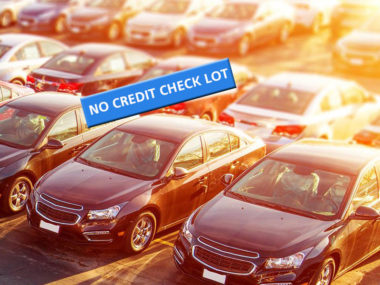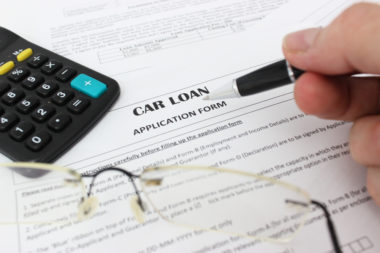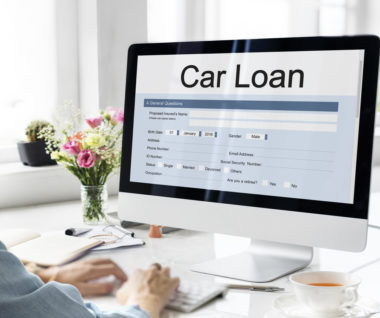Buying your first car is exciting. There are so many options to choose from, however, before you start test driving, there are some things you need to know in order to make it go as smoothly as possible.
You should create a budget, determine which banks are offering the best loans, research reputable dealers, and get pre-approved for your loan.
Table of Contents
Create a Budget
Deciding on a budget is a crucial first step before you ever walk onto a car lot. You should know how much you’d like to spend and exactly what your bottom line is before you start talking to dealers. Avoid looking at unnecessary cars out of your payment range. Creating a budget also gives you time to come up with ways to save money for the car, or the down payment. It is also important to create a budget to avoid being tempted or persuaded to try and purchase something outside of your price range.
If that happens, you’ll either be denied the loan completely or you’ll be left with a hefty monthly payment that you won’t be able to manage. In the end, you’ll have more stress than you bargained for, and if you’re not able to make your payments your car could ultimately be repossessed.
First, sit down and think about what kind of payment you can manage per month. Examine your finances and understand how much wiggle room is available in your budget. You should try to be conservative and save as much additional money in your budget as you can.
For example, if you find that you have $300 you can spend on a lease each month, it would be wise to try and spend less than that. You don’t want to be completely tapped out after paying all of your bills. This might mean choosing between a new and used car. Choosing a used car will undoubtedly save you money each month. Once you have an idea about what you’d like to spend, then you can have some loan conversations.
Determine Payment Method
An easy way to help determine your budget is to decide how you are going to pay for the car. There are two primary options for purchasing a car:
- Cash: Paying for the car outright in one lump sum;
- Loans: Making payments with interest negotiated in the contracts terms (examples include leasing, in-house financing, outside financing).
Shop for Loans
Unless you are using cash, or someone else is paying for the car for you, you will need to obtain a loan. There are different types of loans, so you need to do your research, figure out how much you can spend, have an understanding of credit, and shop for which one is best for you personally.
Do Your Research
After you’ve got a stable monthly price range that you’d like to stay within, you can check out some lenders and see what options they have for you. It’s not a bad idea to do some preliminary research and start to find out what kinds of cars will be available in that range.
However, it’s important to not become set on any one particular car. Once you actually start having conversations with a lender they might give you some insight into why a certain car may or may not work for you. Not to mention, when or if you test drive it later you could change your mind. For the time being, just try to stick to research.
Know How Much You Can Spend
The bank is also going to talk to you in terms of a lump sum, so you should become familiar with this now. They might ask you how much you’re willing to spend in total and you should know how long you’d like to be paying off the car.
For example, if you settle on a $150 monthly lease payment that lasts for four years, you’re likely going to be paying more than $7,000 total on the car. Taxes, fees, and interest will add a good chunk of change to the top of your loan. Therefore, it’s good to do some math beforehand and start figuring out both your monthly allowance and how long you’d like to be paying that off.
Again, remember to think about new versus used cars. A used car will mean that you’re paying it off for less time and will owe less in total. Most auto loans are in the three to five year range, but it completely varies depending on the lender. You might be able to do less or more, but only if your bank allows it.
Understand Interest
Now that you’ve done some of your own calculations, look around at a few lender websites and see what kinds of lease lengths they offer as well as what additional charges you’ll be looking at. You should know how much you’re going to be paying in interest and how that will affect your loan total.
Adding fees and interest to your loan could substantially increase your loan total, bringing you up to a completely new price bracket that you didn’t originally intend for. Now is the time to play out some hypothetical scenarios and see which ones you’re most comfortable with.
Know Your Credit Score
The other half of this has to do with your credit score. If you don’t have any other lines of credit in your name, such as a credit card, you likely have no credit. This means that banks won’t know how reliable you are yet with your monthly payments. It is possible to buy a car without credit, but it will require going through additional hoops.
How to Build Your Credit
If you don’t think that you can get a cosigner, but you don’t have any credit, you’ll need to look into building your credit by yourself. A credit card is a great place to start. Look around for a bank that offers a low-limit credit card, maybe $200 to $500. These are often easy to be approved for, and you can build up your credit score slowly by using one and paying it off regularly.
However, it may take six months or more of this type of activity for you to build up enough credit to be approved for a car loan, so be aware of that if you’re thinking about this route. The longer you build up your credit, the more likely it is that you’ll be approved for a larger loan.
Research Cars
Now that you understand exactly how much you have to spend each month as well as what your total loan amount and terms will look like, you can begin researching your future car. Take a look at cars that are selling around the price range you’re looking for. Decide if new or used cars are going to be a better idea for your budget. Again, it’s important to not get set on any one car. You’ll have to compare cars, their features, their price, mileage, gas consumption and more.
The car that is best for you depends on what you are using it for. Think about how you’ll be using this car on a daily basis and what the most important features are for your needs. This will help you eliminate cars that definitely won’t work for you and are just not worth buying. You’ll likely also find some new features that you didn’t think about which are important to you as well. These are the things you’ll want to know before you actually start having conversations with dealers.
Research Dealers
Once you have an idea of what cars you’re looking for, it’s time to do research on sellers. Read reviews of sellers online and make sure that there are no red flags that come up.
It helps if you can find a seller that has a reputation for being fair with people buying their first car. Many dealers will try to upsell you to a newer model or similar car that has more features. Keep in mind that sticking with a used car (if that’s what you prefer) will save you heaps of money. If you’re properly armed with knowledge, you’ll be able to stand firm with what you want.
Shopping for your first car can be intimidating though, so it’s not a bad idea to ask someone to go with you. Your cosigner or someone who is experienced with buying cars would be a great choice. They can help back you up and make sure you don’t get steered in the wrong direction. In order to combat this, you should be prepared before you decide to reach out to a particular dealer and make sure you know exactly what you’re looking for.
The same goes for a private seller that doesn’t work for a dealership. You should do research on the car they’re selling, the features it has, and the condition that it’s in. You should know if they’re selling for a fair price and if that will align with your financial plan. Just like with the dealership, you should bring someone with you.
Get Pre-Approved on Your Auto Loan
Since you now have an idea of what kind of car (new or used), price range, and monthly payment you’re wanting, you can reach out to one of the banks you researched earlier. Pre-approval is a really smart idea before you start working out any details about a particular car. It’s the bank saying that they will loan you an “x” amount of money for this certain type of car.
The bank will ask you to show proof of income, provide the car’s sale price versus the booking value, and they will check your credit. If all of these areas check out, they will give you the stamp of approval to proceed with the car purchasing process
This will also make things much cleaner when you’re ready to pull the trigger on a purchase. Once you’ve decided on a car, you’ll just need to get the dealer in contact with your bank to finalize all the paperwork. If you don’t get pre-approved, you’ll have to wait and see if you’re approved before anything can go through. It takes more time, it’s messier, and it’s a complete gamble as to whether you’ll be approved. So, once you’re pre-approved, you can go ahead and test drive.
Test Drive
Everything can look good on paper, so you will want to allot some time to take the car you are interested in on a test drive. Don’t let a polished exterior fool you, you should be looking at more than the body of a car when you’re deciding on which one to buy. If you’re looking for a used car, make sure that you ask questions about the car and any previous owners. You should know if the car has been repaired or if it was in any accidents.
In addition, take a close look at the seats, try out all the features of the car to make sure they work, and make sure it feels physically comfortable. Your dealer should disclose how many miles have been put on the car and its maintenance history.
Ask them how old the tires are and if a new battery has been put in recently. Pop the hood and take a look at the engine — it should be fairly clean with no signs of corrosion. Ask the dealer how it runs to make sure it is safe to drive before you actually do so.
As long as all of these things are up to standard, take it for a ride and make sure you listen to the car. Everything should sound like it’s running smoothly and it shouldn’t have any problems (e.g. stalling or grinding) when changing gears.
Make sure that the breaks work properly and that the brake pads aren’t getting too worn out — you can tell this by a squealing sound and the need to use excessive force to come to a stop. Although some of these areas aren’t too expensive to fix on your own, you should make sure that you know what you’re getting into before you buy it. If the seller claims that it’s ready to drive home today, it should be exactly that
Close the Deal
If you find a car you like, make sure to take some time to think about the purchase. Most salesmen will try to persuade you to purchase the vehicle immediately for the one time price, but there are sales year round for cars — not to mention the art of negotiation. If you fall in love with a car you didn’t research, taking time to think over your purchase can help you make sure that you are getting a fair price, and that it does fit your needs along with your budget.
Make sure to use price estimation sites such as Kelly Blue Book and NADA to help you determine a fair price for the car. Dealers need to mark prices up to ensure their profit, but you want to make sure that you aren’t overpaying. Be ready to provide this information to the salesman if the price varies to discuss why that is.
Use the following tips for closing the deal:
- Negotiate one thing, not multiple: The more moving parts, the less likely for the seller to say yes. If you want a lower monthly payment, negotiate price or term. If you want new tires, negotiate them into the asking price;
- Take a day (or more) to think: More often than not, you don’t need to buy the car that very second. If you are on the fence, put a deposit down to hold the price if it is fully refundable;
- Avoid talking about your loan approval amount: Just because you are approved for $30,000 doesn’t mean you need to spend that much.
In the end, there is no reason why you can’t get a great car at a fair price. Your first car buying experience is an exciting adventure and it’s something that you’ll always remember.
Remember, you have to be willing to put in the time to research the cars that will practically fit your life and budget. Researching dealers, test driving, and pre-approval are also all important aspects of this process that you shouldn’t ignore. If you are focused and dedicated to getting the best deal and you follow these steps, you will undoubtedly walk away with a car you are proud of.
Image Source: https://depositphotos.com/





